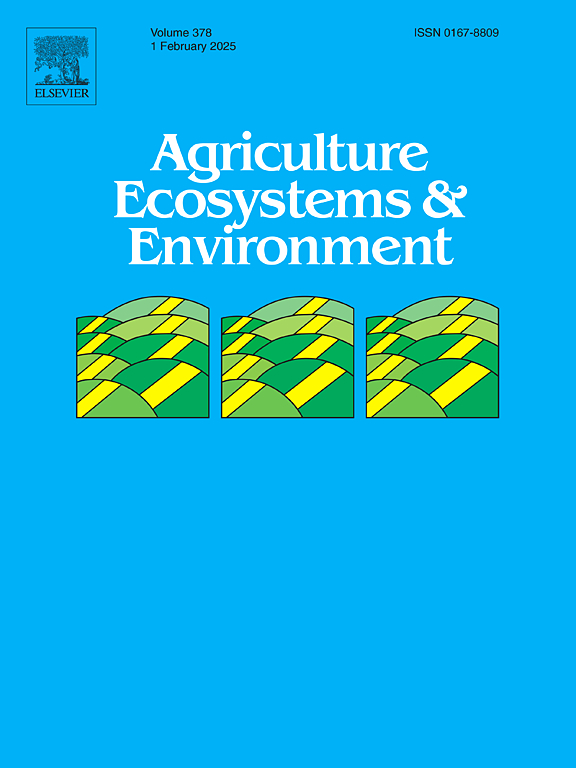Spatial variability of agricultural soil carbon dioxide and nitrous oxide fluxes: Characterization and recommendations from spatially high-resolution, multi-year dataset
IF 6
1区 农林科学
Q1 AGRICULTURE, MULTIDISCIPLINARY
引用次数: 0
Abstract
Mitigating agricultural soil greenhouse gas (GHG) emissions can contribute to meeting the global climate goals. High spatial and temporal resolution, large-scale, and multi-year data are necessary to characterize and predict spatial patterns of soil GHG fluxes to establish well-informed mitigation strategies, but not many of such datasets are currently available. To address this gap in data we collected two years of in-season soil carbon dioxide (CO2) and nitrous oxide (N2O) fluxes at high spatial resolution (7.4 sampling points ha−1) from three commercial sites in central Illinois, one conventionally managed continuous corn (2.8 ha in 2021; 5.4 ha in 2022) and two (one site 5.4 ha in 2021 and 2.0 ha in 2022, another site 2.7 ha both years) under conservation practices in corn-soybean rotations. At the field-scale, the spatial variability of CO2 was comparable across sites, years, and management practices, but N2O was on average 77 % more spatially variable in the conventionally managed site. Analysis of N2O hotspots revealed that although they represent a similar proportion of the sampling areas across sites (conventional: 12 %; conservation: 13 %), hotspot contribution to field-wide emission was greater in the conventional site than in the conservation sites (conventional: 51 %; conservation: 34 %). Also, the spatial patterns, especially hotspot locations, of both gases were inter-annually inconsistent, with hotspots rarely occurring in the same location. Overall, our result indicated that traditional field-scale monitoring with gas chambers may not be the optimal approach to detect GHG hotspots in row crop systems, due to the unpredictable spatial heterogeneity of management practices. Meanwhile, sensitivity analysis demonstrated that reliable (< 25 % error) field-scale soil GHG flux estimates are attainable when sampled above certain spatial resolutions (1.6 points ha−1 for CO2 and 5.6 points ha−1 for N2O in our dataset). Especially for N2O, lower spatial resolutions were prone to underestimating its field-wide flux.
农业土壤二氧化碳和氧化亚氮通量的空间变异性:来自空间高分辨率多年数据集的特征和建议
减少农业土壤温室气体(GHG)排放有助于实现全球气候目标。高时空分辨率、大尺度和多年数据对于表征和预测土壤温室气体通量的空间格局以制定知情的缓解战略是必要的,但目前可获得的此类数据集并不多。为了解决这一数据差距,我们在伊利诺伊州中部的三个商业地点以高空间分辨率(7.4采样点ha - 1)收集了两年的季节性土壤二氧化碳(CO2)和氧化亚氮(N2O)通量,一个传统管理的连续玉米(2.8 ha)在2021年;在玉米-大豆轮作的保护措施下,2022年为5.4 ha)和两个(一个地点2021年为5.4 ha, 2022年为2.0 ha,另一个地点两年为2.7 ha)。在野外尺度上,CO2的空间变异性在不同地点、年份和管理方式之间具有可比性,但在常规管理方式下,N2O的空间变异性平均高出77 %。对N2O热点的分析表明,尽管它们在各个站点的采样区域中所占的比例相似(常规:12 %;保护点:13 %),热点对全场排放的贡献在传统点大于保护点(传统点:51 %;保护:34 %)。此外,两种气体的空间格局,特别是热点位置,年际间不一致,热点很少出现在同一位置。总体而言,我们的研究结果表明,由于管理实践的不可预测的空间异质性,传统的田间毒气室监测可能不是检测行作系统温室气体热点的最佳方法。同时,敏感性分析表明,该方法可靠(<;25 %误差)当采样高于一定的空间分辨率(我们数据集中CO2为1.6点ha - 1, N2O为5.6点ha - 1)时,可以获得现场尺度的土壤温室气体通量估算。特别是对于N2O,较低的空间分辨率容易低估其场通量。
本文章由计算机程序翻译,如有差异,请以英文原文为准。
求助全文
约1分钟内获得全文
求助全文
来源期刊

Agriculture, Ecosystems & Environment
环境科学-环境科学
CiteScore
11.70
自引率
9.10%
发文量
392
审稿时长
26 days
期刊介绍:
Agriculture, Ecosystems and Environment publishes scientific articles dealing with the interface between agroecosystems and the natural environment, specifically how agriculture influences the environment and how changes in that environment impact agroecosystems. Preference is given to papers from experimental and observational research at the field, system or landscape level, from studies that enhance our understanding of processes using data-based biophysical modelling, and papers that bridge scientific disciplines and integrate knowledge. All papers should be placed in an international or wide comparative context.
 求助内容:
求助内容: 应助结果提醒方式:
应助结果提醒方式:


